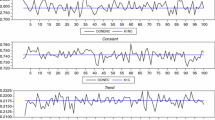Abstract
Ng and Perron (Econometrica 69:1519–1554, 2001) demonstrated the merits to employing their Modified Akaike Information Criterion to select the optimal lag length in the Elliott, Rothenberg and Stock (Econometrica 64:813–836, 1996) unit rot test. Perron and Qu (Econ Lett 84:12–19, 2007) introduced an empirical method that resolved an associated power problem for non-local alternatives. While Cheung and Lai (Oxford Bull Econ Stat 57:411-419, 1995) contains response surface estimates to generate finite-sample, lag-adjusted critical five and ten percent values for use in applied work, these relate to the original Elliott et al. (Econometrica 64:813–836, 1996) test. This paper provides response surfaces estimates of critical values for both the Ng and Perron (Econometrica 69:1519–1554, 2001) and Perron and Qu (Econ Lett 84:12–19, 2007) approaches, demonstrating they are sometimes quite different, an important consideration when performing inference.



Similar content being viewed by others
Data and Computer Code Availability
Matlab programs to replicate the analysis and calculate finite sample lag adjusted critical values and probability values are available as electronic supplementary material and also at http://web.business.queensu.ca/faculty/psephton under MatlabFiles (ADFGLS2020.zip) and on request to the author (Peter.Sephton@queensu.ca).
Notes
References
Cheung, Y., & Lai, K. (1995). Lag order and critical values of a modified dickey-fuller test. Oxford Bulletin of Economics and Statistics, 57, 411–419.
Elliott, R., Rothenberg, T., & Stock, J. (1996). Efficient tests for an autoregressive unit root. Econometrica, 64, 813–836.
MacKinnon, J. (1994). Approximate asymptotic distribution functionsn for unit root and cointegration tests. Journal of Business and Economic Statistics, 12, 167–176.
MacKinnon, J. (1996). Numerical distribution functions for unit root and cointegration tests. Journal of Applied Econometrics, 11, 601–618.
Ng, S., & Perron, P. (2001). Lag length selection and the construction of unit root tests with good size and power. Econometrica, 69, 1519–1554.
Ng, S., & Perron, P. (2005). A note on the selection of time series models. Oxford Bulletin of Economics and Statistics, 67, 115–134.
Otero, J., & Baum, C. (2017). Response Surface Models for the Elliott, Rothenberg, and Stock Unit Root Test. The Stata Journal, 17(4), 985–1002.
Perron, P., & Qu, Z. (2007). A simple modification to improve the finite sample properties of Ng and Perron’s unit root tests. Economics Letters, 84, 12–19.
Schwert, G. (1989). Tests for unit roots: A monte carlo investigation. Journal of Business and Economic Statistics, 7, 147–159.
Seo, M. (2005). Improving Unit Root Tests by a Generalization of the Autoregressive Spectral Density Estimator at Frequency Zero. Unpublished Manuscript, Department of Economics, London School of Economics.
Sephton, P. (1995). Response surface estimates of the KPSS stationarity test. Economics Letters, 47, 255–261.
Sephton, P. (2008). Critical values of the augmented fractional dickey fuller test. Empirical Economics, 35, 437–450.
Sephton, P. (2009). Critical values for the augmented efficient wald test for fractional unit roots. Empirical Economics, 37, 615–626.
Sephton, P. (2017). Finite sample critical values of the generalized KPSS stationarity test. Computational Economics, 50, 161–172.
Funding
None.
Author information
Authors and Affiliations
Corresponding author
Ethics declarations
Conflict of interest
The author declares he has no conflicts of interest.
Additional information
Publisher's Note
Springer Nature remains neutral with regard to jurisdictional claims in published maps and institutional affiliations.
Rights and permissions
About this article
Cite this article
Sephton, P.S. Finite Sample Lag Adjusted Critical Values of the ADF-GLS Test. Comput Econ 59, 177–183 (2022). https://doi.org/10.1007/s10614-020-10082-6
Accepted:
Published:
Issue Date:
DOI: https://doi.org/10.1007/s10614-020-10082-6




